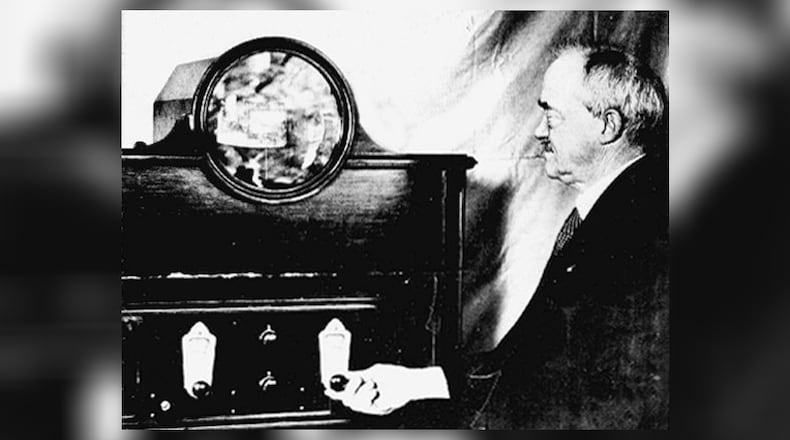Jenkins was issued more than 400 patents during his career, many of them related to television and motion pictures.
Making movies
Jenkins was credited with the invention of the movie camera and other related devices. in 1927, he talked to the Dayton Daily News about being an inventor.
“I doubt if any pioneer inventor knows just how his big idea first struck him. It just sneaks up on him. The first thing you know you’ve got a crazy idea and begin to play with it,” he said. “It was between 1890 and 1893 that I began to play with the movie idea. I got the idea of making a rapid succession of exposures of the same object, speeding it up in a magic lantern. For want of anything else, I called the result a ‘device for recording and preproducing motion.’”
He invented the motion picture projector and became the first man to throw movies onto a screen.
“The first pictures I ever projected were made on a silk handkerchief, stuck against the wall, in 1892,” Jenkins said back then. “I had to make a new little camera to take pictures rapidly and had to make my own film by splitting regular Kodak film into three strips and sticking it together with collodion to make a long strip which I turned with a crank as movie photographers do today. I even had to invent a new developing device for such a long strip of film.”
About the same time, Thomas Edison was working on his “kinetoscope,” in which one could see movies by looking down into a box. The Jenkins invention was called a “phantoscope.”
After nearly going broke, he teamed with Thomas Armat and opened what could be considered the world’s first movie theater at the Cotton States Exposition in Atlanta in 1895. The theater later was damaged by a fire, ending that endeavor.
Patents sold
Jenkins became skeptical that his invention would catch on. After a disagreement with Armat, their partnership was dissolved. Jenkins sold Armat the rights to the phantoscope. Armat turned around and sold the patent to Thomas Edison, without Jenkins’ consent.
“I took the $5,500 and went out with my girl and we had a whale of a good time,” Jenkins said later.
Radio-vision
Jenkins was ready to move on to his next idea.
He invented a television system he called “Radio-vision.” Jenkins was the first to transmit moving images over the airwaves when he broadcast 10 minutes of a windmill going around in June 1925.
Jenkins was also the inventor of the lamp which performs the task of transforming radio waves to light and shadows by lighting and extinguishing itself a half million times a second.
This marvelous globe earned itself the name of “the modern Aladdin lamp.”
The Jenkins radio-vision lamp operated on what was known as the Wheatstone bridge principal, where a little change in electric voltage gave a large change in light flux of flow. The motion picture was then converted at the transmission station into electrical values to be carried over radio carrier waves. The radio lamp would then reverse the process, changing the electric current back to picture values.
Though the machine couldn’t reproduce the scenes at a baseball game or any other similar event, Jenkins predicted in 1925 that in a few years that a machine would be developed to the point where radio fans might sit at home and see every move and hear every cheer in a World Series.
Big test
The first public demonstration of radio vision was held before officials in Washington, D.C. on June 13, 1925.
With Secretary of the Navy Curtis Wilbur and other prominent government representatives grouped before the device, the operators became so excited that half the stunt was omitted.
The plan was for a view of a moving object was to be transmitted over seven miles and was to be joined by a radioed explanation of how it was done, all sent from one instrument and on a single wave length.
“In my excitement and the excitement of my assistants,” Jenkins explained, “we forgot to talk.”
During another experiment in Washington, sent from his lab to a Navy transmitting station, the signal kept going in and out. Just before the arrival of government officials, the receiver was only showing black specs.
“I was terribly disappointed,” Jenkins said, “and began to frame an alibi, suggesting to my visitors that the machine might not always work. I led them back to the receiving room, but one look on the face of my assistant told me he had brought the radio vision back on the plate.”
Jenkins later worked with the Navy to install a system he invented that allowed daily weather maps to be sent to ships at sea.
W3XK
In 1928, Jenkins began selling radiovision sets that could pick up broadcasts from his station, W3XK in Wheaton, Maryland. The station, which was the first television broadcasting station in the U.S., transmitted telecasts of radio movies produced by his company, Jenkins Laboratories, Inc.
Even though the receivers required viewers to regularly re-tune in the broadcast and the pictures were sometimes so dark that the announcer would have to describe the scenes, it was considered well worth the effort.
By the end of 1928, 18 stations were broadcasting across the U.S. Before it ended in 1932, it was estimated that 20,000 people were watching.
Competition from abroad
In 1926, 24-year-old Hiroshi Ando of Japan made a device described as a radio telephone that allowed for a person using the device to see the person on the other end of “the line.”
He also believed his device would make “radio movies” practical.
Jenkins had developed a machine for transmitting motion pictures by wireless, but it was not known his method was similar to that used by Ando.
Reports out of London in 1927 told that British inventor J.L. Baird had perfected his “television” and had formed a company to sell his devices.
Jenkins Television Corp.
In 1928, Jenkins, by then known as the father of the motion picture industry, became vice president in charge of research and a director of a new company known as the Jenkins Television Corp. which was to “manufacture and sell home movie television sets.”
Jenkins stayed with the company for four years. It then changed hands a couple times before eventually being owned by RCA.
In 1936, RCA demonstrated an all-electronic television broadcast. Then in 1954, RCA produced the first color TV set, the CT-100.
About the Author







